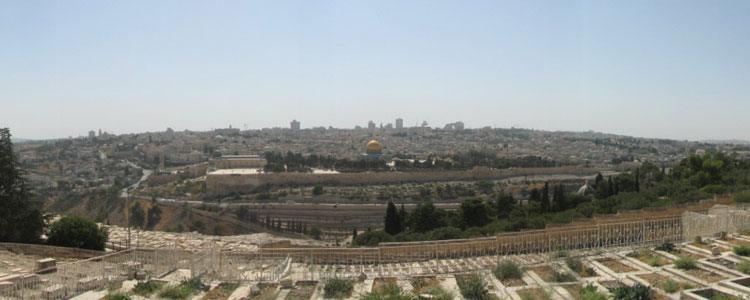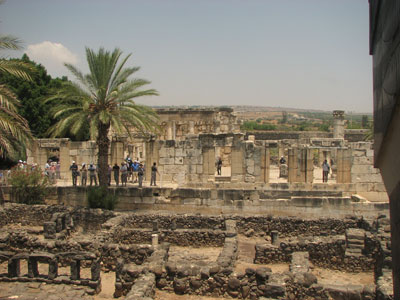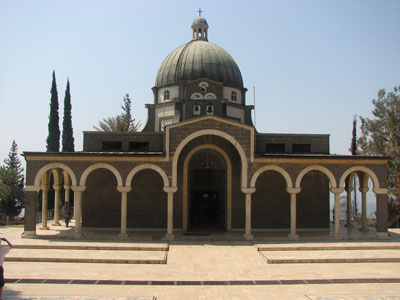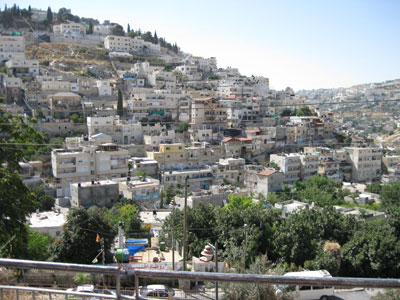Impressed on a pilgrimage to Israel
by Kathie Swift; Des Moines, IA
The first question that’s usually asked about our pilgrimage to Israel is “Did you feel safe?”
“Yes, all the time!” we enthusiastically answer.
Everywhere we went in the Holy Land — across fertile plains and hot desert sand, exploring monasteries and holy places, big cities and small villages — we found a country that is a treasury of history, friendly people and spiritual beauty.
About the tour
For 10 days in June ’11, Father Larry Hoffman, then-pastor of St. Theresa’s Catholic Church in Des Moines, shepherded our group of 20 parishioners, beginning with our flight to Tel Aviv. We arrived mid afternoon, cramped and sleepy but eager to explore this 8,000-square-mile strip of land.
Reflecting its long history, both town and country appeared a bit weary and worn, but life and energy pulsated in the restaurants and trendy shops.
Our smiling, scholarly guide, Nader Mascobi, welcomed us, distributing hats, maps and a warning to drink water constantly. All during the tour, booked through Ed-Ventures (Rochester, MN; 800/658-7128), Nader, an Arab Christian, amazed us with his knowledge of the area and his understanding of its religious and social history.
His expertise was honed out of tense events in his own life. Just after earning his professional tour license, with expectations of a busy career, the Gulf War erupted, leaving him unemployed for five years. While balancing part-time jobs, he filled his days and nights studying Middle Eastern history, architecture, culture and religion.
During our tour of this tumultuous land, which cost $3,588 per person, including airfare and insurance, we saw kibbutz farmland; lush pastures; feathery, gray-green olive groves; basilicas; ancient sites, and colorful markets. Nader reminded us that a particular site could never be absolutely claimed as the location of this or that historical event. After all, in a country 4,000 years old, who can say for sure?
Settling in
Once clearing the ultramodern steel-and-tile Ben Gurion Airport, we settled into our comfortably cool motorcoach and headed to Jaffa, one of the oldest port cities in the world. We stretched our legs, almost blinded by the blazing sun and the glittering blue-and-silver sparkle of the Mediterranean coast.
After check-in and dinner at our hotel, we walked a short distance to the beach, chatting and exploring until it grew dark. It was a very special beginning to our pilgrimage.
We stayed in Israeli hotels, all characterized by kosher soup-to-dessert buffets that were heavy on fresh salads, eggplant, meat stews and chicken legs (only legs).
One night we were awakened by the sudden silence of the ever-droning air-conditioners; a power failure had shut down all electricity. Our neighbor across the hall hiked down eight flights of stairs to find the lobby abuzz with maintenance workers and startled guests. The energy was soon restored.
On our second day, we rose early for a bountiful breakfast buffet (no coffee offered), then boarded our bus to drive through the Sharon Valley. We headed to Caesarea, Herod the Great’s deepwater-port city. Its impressive Roman amphitheater, King’s Palace and aqueduct, as well as fortifications built by the Crusaders, illustrated the architectural might of King Herod, who ruled from 37 to 4 BC.
Biblical reminders
One day we set sail on the Sea of Galilee, also known as Lake Kinneret, in an open boat described as one similar to those of Biblical times. It was a beautiful, sunny day and our crew entertained us with fishing tales.
Tiberias, one of the four holy cities of Judaism, is the largest city on the shore. The fishing nets there reminded us of the overflowing catches mentioned in the Bible.
Later we lunched on “St. Peter’s Fish,” served whole and blackened from the restaurant grill — very bony!
A stop at verdant Mount Carmel gave us a 360-degree view of the Mediterranean. The Stella Maris Carmelite Monastery complex offered the chance for Fr. Hoffman to say Mass in a shaded grove.
The tour continued to Acre (Akko) and the monumental Crusaders’ city, which now lies underground. Inside the city gate, Nader told us that Arabs and other desert dwellers live in conditions of constant heat, traveling long distances and dealing with stubborn camels. All, he said, require patience.
The next day, we traveled to the site believed to be that of biblical Cana, in Galilee, where Jesus turned water into wine for wedding guests. Several couples in our group renewed their wedding vows in the chapel there.
In Nazareth, we viewed the Holy Family’s home; the Basilica of the Annunciation, and the ancient village, and we celebrated Mass at the Basilica of the Transfiguration.
The next morning we found ourselves atop the flower-filled gardens of the Mount of Beatitudes, the site of the Sermon on the Mount. Down at the base of the mountain, in Tabgha, we marveled at the splendid mosaic depicting the miracle of the loaves and fishes.
In Capernaum, the center of Christ’s Galilee ministry, we explored the ancient marble synagogue where Jesus taught. Saint Peter’s tiny house is preserved inside the new church of the House of St. Peter, plopped atop town excavations.
Yardenit, the Baptismal site on the River Jordan, concluded the day’s wanderings. The area boasts a huge new tourist complex complete with souvenir shot glasses and T-shirts — somewhat jarring when contrasted with the spiritual beauty and significance of the place.
On to Jerusalem
On the road to Jerusalem we stopped at Bet She’an, a major archaeological site imprinted by Egyptians, Canaanites, Israelites, Greeks and Romans.
Qumran assailed us with a sharp, dusty wind and barren landscape dotted by caves and deep crevices. It was here that the ancient Essene community nurtured the Dead Sea Scrolls, hiding these ancient treasures of Hebrew history and culture in caves, where they were discovered beginning in 1947.
We crossed through an Arab market filled with shopkeepers and shoppers in traditional Arab dress. I asked Nader if Israelis would shop there as well. “Not many,” he said. “We are constantly at war.”
With spellbinding commentary and wise insights, Nader made our visit to Jerusalem a joy of place and history. It was late afternoon when, under blue skies and hazy afternoon sun, our bus rounded a bend in the road and we caught our first glimpse of this holy city.
The long swath of low, light-colored limestone buildings, curving rooflines and massive gates along with the golden glow of the monumental Temple Mount evoked “oohs” and “ahs.”
The Mount of Olives provided a thrilling overview of the Old City.
Entering the Old City through St. Stephen’s gate, we visited the Church of St. Anne and the Pool of Bethesda, continuing on to Mount Zion, King David’s tomb and the Upper Room (the site of the Last Supper).
Subsequent stops included the Garden of Gethsemane, lush with pink and purple flowers, and the Church of the Holy Sepulchre. Here a chapel marks the spot where many believe Jesus was stripped of his robe, an altar indicates where He was nailed to the cross, and an ornate shrine sits above the rock where He is said to have been crucified.
The Ethan and Marla Davidson Center Exhibition & Virtual Reconstruction Center, located at the entrance to the Jerusalem Archaeological Park, displays the history of the Temple Mount through archaeological artifacts spanning 2,000 years. After experiencing the display, we moved on to the massive Western Wall, part of the last remnants of the Second Temple. Here Jews, Christians and other believers pray, touch, mourn and tuck petitions into the gaping cracks, weeping and swaying rhythmically.
Modern-day reminders
The Mount of Remembrance memorializes fallen soldiers and Israeli leaders at Mt. Herzl. Also housed there are the buildings of Yad Vashem, including the amazing and acclaimed Holocaust History Museum, a stunning repository of the history and horrors of the period.
We arose early to walk the winding, mile-long Via Dolorosa in the cool of morning, stopping to meditate at the 14 stations marking Jesus’ final journey to Calvary. I was reminded of another early- morning departure during our tour, awaiting our turn to gingerly creep down the steep, well-worn stone steps into the tiny cave where Jesus was born.
At the end of our final day, we slept just a few hours before driving through the night to reach the airport in Tel Aviv. The security lines were very long although efficient and thorough. Even though tired to the bone from the heat and pace of the pilgrimage, I breathed in new energy with the realization that we had been where Jesus walked.




